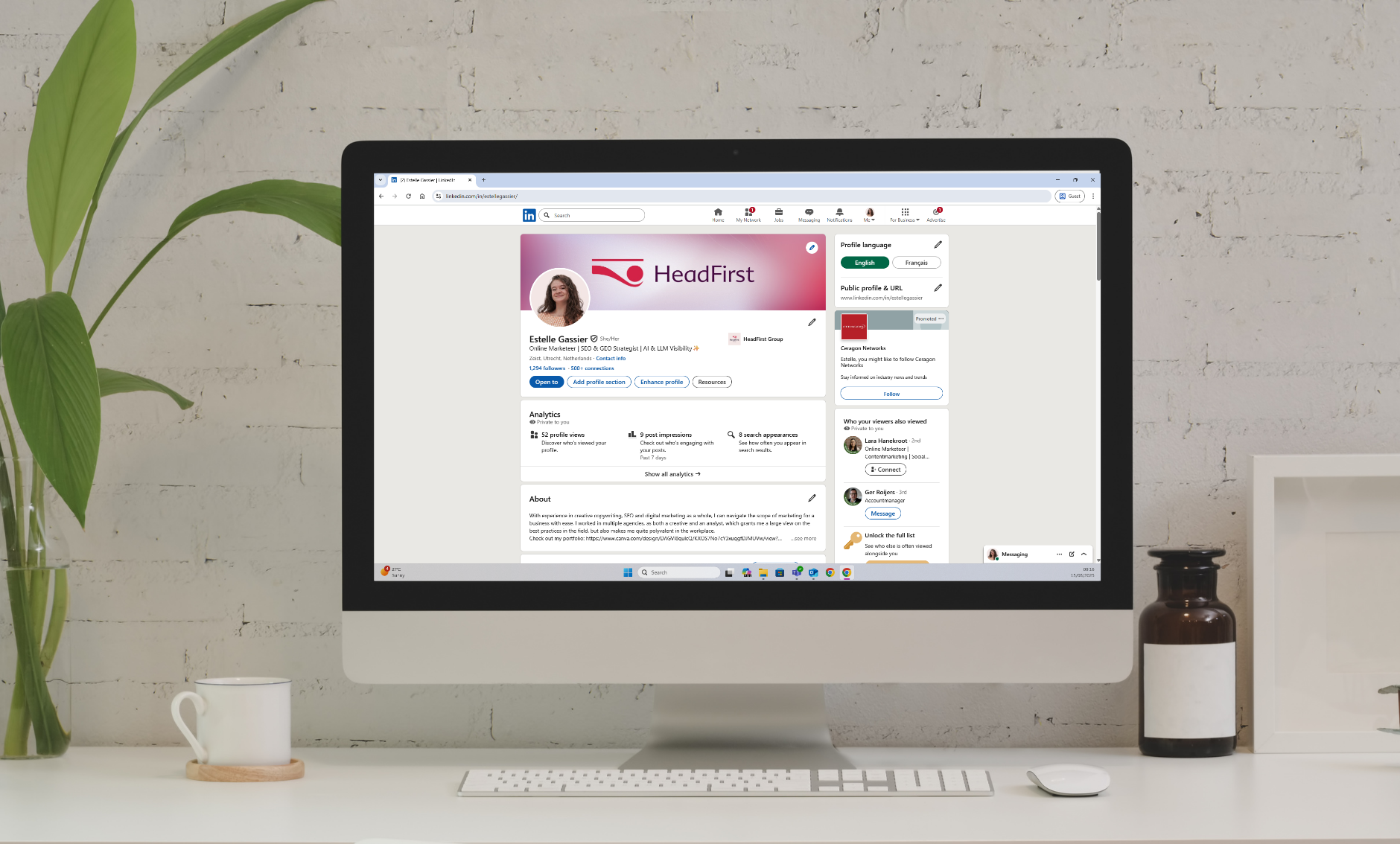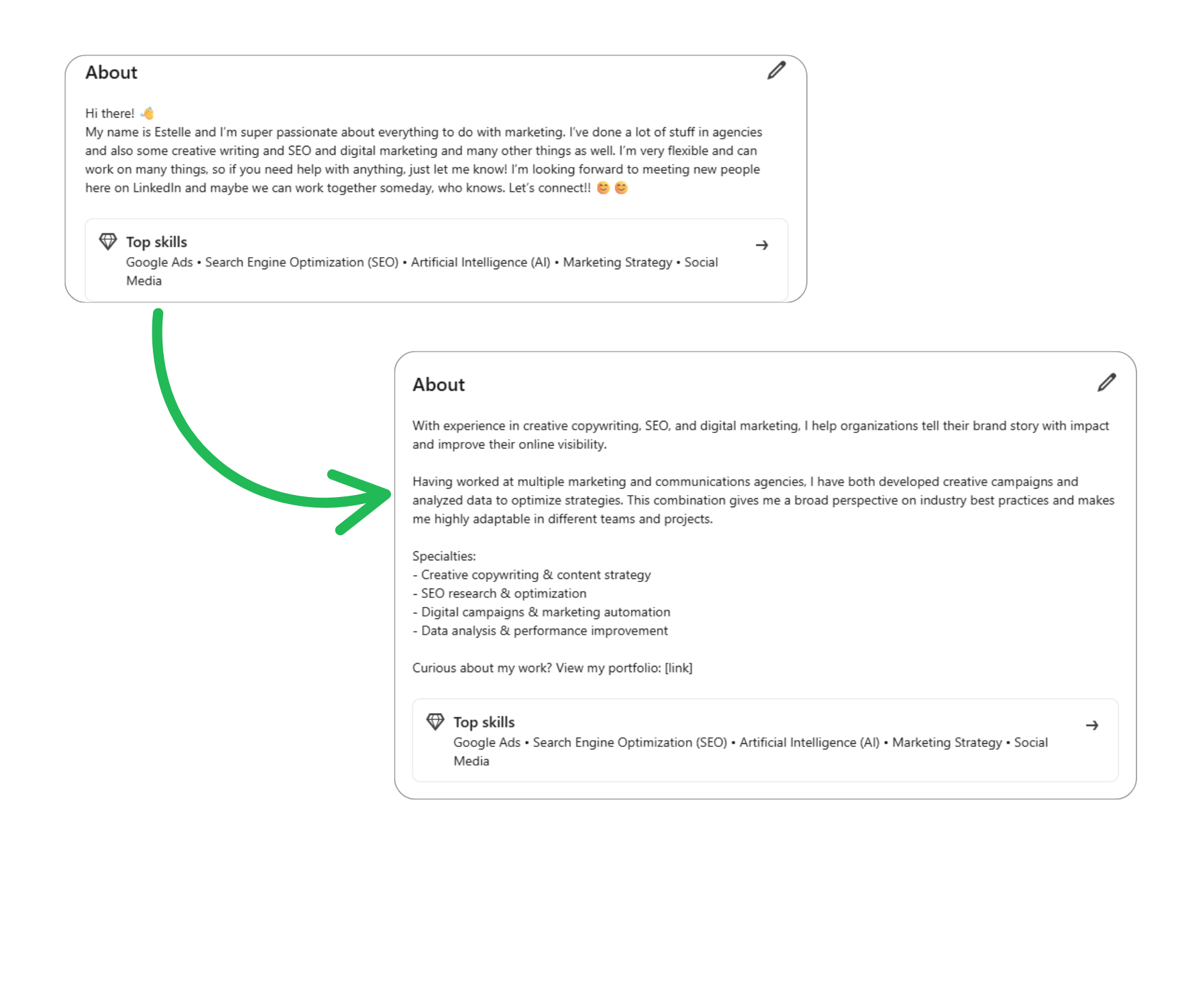How Recruiters View Your LinkedIn Profile (and How to Optimise It)
Recruiters assess your LinkedIn profile based on a clear headline, relevant experience, skills, and recommendations.
Recruiters use LinkedIn every day to find professionals who match a role or assignment. The good news: you can predict how they look at your profile, and shape your profile to meet that scan. This guide walks you through the recruiter’s view, with practical, Netherlands-specific examples and steps you can take today.

The First 12 Seconds: What Stands Out Immediately
Recruiters make a fast call on whether your profile is worth a deeper read. In those first seconds they notice:
- Profile photo & banner. Professional, recent, approachable. Skip holiday pics; choose a calm background.
- Headline. Is it clear what people can hire you for? Use plain, widely used job titles and specialisms, e.g. Functional Application Manager | AFAS | Incident & Change or SEO Specialist | Technical SEO & Content Strategy.
- Latest role & location. Does your current role align with the opening? Are you within reasonable distance (think Randstad, Brainport, Arnhem/Nijmegen regions)?
Quick win: A head-and-shoulders portrait, subtle smile, eye contact, and the clothes you’d wear to a client meeting.
How You Get Found: How Recruiters Search on LinkedIn
Recruiters work with keywords and filters. If you use the right terms in the right places, you’ll rank higher in search results.
Job Titles, Skills, and Keywords
- Use common NL job titles (e.g. Scrum Master, DevOps Engineer, BI Analyst, Online Marketer).
- Place your core skills in your headline, About, and in each experience entry (e.g. Kubernetes, Azure, Power BI, Accessibility, CRO).
- Repeat important keywords naturally across your profile; avoid keyword stuffing.
Location, Commute Range, and Availability
- Set your location (e.g. Utrecht, Eindhoven, The Hague area). Many roles list a base location with hybrid expectations.
- Freelancing? In your availability, mention an hourly rate range and where you work (on-site Randstad/remote). It signals fit and reduces back-and-forth.
“Open to Work”: Visible to Recruiters
- Open to Work helps you signal interest. If discretion matters, choose the setting that’s visible to recruiters only (platforms cannot guarantee 100% secrecy).
- Add job titles, locations, and contract types. Matching tools use these fields heavily.
Profile Sections That Make the Difference
About (Summary) That Converts
Write 4–6 tight sentences in the first person: who you help, what problem you solve, and what energises you. Add 3–5 core skills and one measurable result.
Voorbeeld (IT):
I help DevOps teams ship faster with stable Azure pipelines. Experience in scale-ups and government. Focus on observability, IaC, and security-by-design. Highlight: led an AKS migration that cut cloud costs by 30%.
Voorbeeld (marketing):
I build durable SEO growth for e-commerce and B2B. Technical SEO, content, and CRO under one roof. Result: +120% organic traffic in 9 months for a Dutch retailer.

Experience: Impact-Focused Bullet Points
Make each role or project scannable:
- Context: company/sector, team/stack.
- Responsibilities: 3–5 bullets.
- Impact: one measurable outcome (+18% conversion, −25% lead time, NPS +1.2).
- Media: attach a case study, deck, or demo to Experience or Featured.
Skills & Recommendations
- Add 20–50 skills and pin your top ones.
- Request 2–3 recommendations per relevant role—ask referees to mention a concrete outcome.
- Keep your skills consistent with your headline and About.
Media and Projects (Featured/Portfolio)
- Showcase a GitHub repo, deck, demo, or article. Creatives: link your portfolio (e.g. Behance).
- Freelancers: enable the LinkedIn Services module and list your specialisms.
Dutch Market Context: Examples and Terms That Help
- Public sector: often requires a VOG and emphasises compliance; mention experience with tenders and standards (BIO, ISO frameworks).
- Tech & data (Amsterdam–Utrecht–Eindhoven): highlight cloud platforms (Azure/AWS/GCP), frameworks (React/Spring), tooling (Terraform/DBT), and security by default.
- Marketing & communications (Randstad): show cases with reach, conversion, SEO growth, brand safety, and omnichannel execution.
Privacy & Transparency (GDPR): What to Share (and What Not)
LinkedIn is public enough to be discoverable, so share wisely:
- Do share: work email (or a professional alias), business phone, and portfolio links.
- Don’t share: BSN, medical information, or sensitive private details.
In recruitment, organisations can’t just research everything about you online; it must be relevant and communicated in advance under GDPR. When you edit heavily, review your visibility and sharing settings to avoid flooding your network with updates.
30-Minute LinkedIn Visibility Checklist
- Refresh photo and banner.
- Rewrite your headline with NL-friendly keywords (job title + 2–3 specialisms).
- Tighten your About in first person and add one measurable result.
- Restructure your two most recent roles into bullets + one outcome each.
- Reorder top skills to reflect current goals.
- Make contact details visible (email + phone).
- Set location and availability; toggle Open to Work if helpful.
- Create a custom URL: linkedin.com/in/yourname.
Common Mistakes (and Fast Fixes)
“Looking for a new challenge” in your headline → replace with Job Title | 2–3 specialties.
Text walls in Experience → convert to 3–5 bullets with one metric.
Vague or dated titles (all-round employee) → normalise to common NL titles.
No contact info → add email/phone to speed up outreach.
No proof → attach one case, deck, or demo in Featured.
Get Moving with Striive
Profile ready? Great. On Striive, we bring clients and professionals together with data-driven matching—so you show up sooner for the right role or assignment and keep control over your journey.